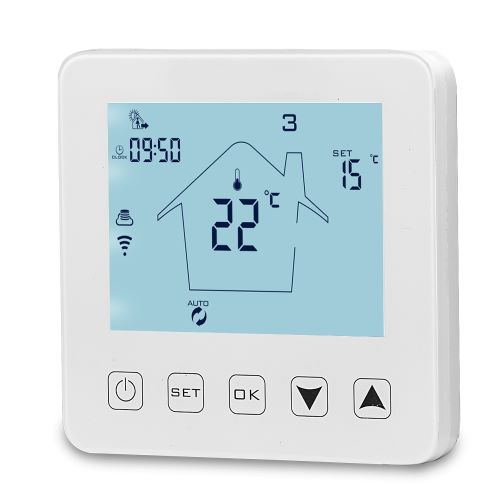Underfloor heating for garden rooms
There are several reasons why underfloor heating is so popular in Garden rooms and outbuildings. Underfloor heating provides a consistent and even warmth across the entire floor, which can create a comfortable and cosy atmosphere inside. You won't experience cold spots or drafts, making it especially appealing during the winter months. Secondly, unlike radiators which use convectional heating that can circulate allergens and dust, underfloor heating produces gentle radiant heat which can be beneficial for individuals with allergies or respiratory issues.
Garden rooms and outbuildings have become increasingly popular as people want to maximise indoor space without having to extend their homes and deal with long and tedious planning applications. An important thing needed for any indoor space is heat and for any garden room or outbuilding electric underfloor heating is easy to fit, takes minimal floor height and allows the room’s floor space to be used to maximum effect for games, cinema or office use.
This page has some important things to consider when planning the installation of underfloor heating in your garden room or outbuilding.

Electric Vs Wet underfloor Heating – Which is most popular for a garden room?
Electric Underfloor heating mats are much more commonly installed within garden rooms and outbuildings for several reasons:
Ease of Install: Electric underfloor heating systems are easier and quicker to install compared to wet systems. They consist of electric heating cables or mats that are installed directly beneath the flooring. In contrast, wet systems require laying pipes with the subfloor which can be more complex and time-consuming unless the subfloor is new.Cost-effectiveness: An electric underfloor heating kit for a garden room will be much cheaper than a wet kit with a separate manifold.
Floor Height: A electric heating mat is only a few millimetres think and will not raise the floor height by much. Wet underfloor heating will cause much larger increase in floor height unless you install them between the joists of a suspended floor or within a new floor
Manifold: All wet systems need a manifold which take up space and are often not practical for a single room.
Why is Electric underfloor heating so popular in Garden rooms?
Running gas pipes back to a garden room or outbuilding is expensive and time consuming. Electric underfloor heating is very popular in garden rooms because all that is needed is an electrical supply to power it.
1) Floor and wall space – No big radiators on the walls or manifolds means there’s more space for furniture and as standard furniture is safe to go over underfloor heating you can maximise use of the entire space.
2) Underfloor heating emanates evenly distributed heat from the floor's surface, making it more stable and less prone to cold spots or drafts from radiators.
3) As garden rooms have their own dedicated electrical supply up to 22m2 of matting can be laid in any garden room or outbuilding if needed.

What floor covering is best in a garden room with electric underfloor heating?
The most common floor coverings for garden rooms and outbuildings are laminate, engineered wood and tiles. LVT, Amtico and Karndean floorings are also popular however be aware they also take the most floor height due to the amount of flexible self-levelling needed.
Carpet
Pro’s: Easy to install on pretty much any subfloor, minimal increase in floor height
Con’s: Need to make sure that tog rating of carpet and underlay is 2.5 or less.
It is easy to fit electric underfloor heating under carpet. First you put a 6mm batten going around the perimeter of the room. You put then place the 6mm Depron “Protect” Board on floor and the underfloor heating is stuck on top. The underlay and carpet simply lay on top of the heating mats.
Thickness:
Matting: Approx 8mm (matting and 6mm insulation)
Insulation: Mostly loose laid but the board on the perimeter should be stuck down with double sided tape.
Laminate and Engineered wood
Pro’s: easy to fit, minimal increase in floor height, no need for any tile adhesives or self-levelling compounds.
Con’s: None
Fitting electric underfloor heating under laminate and engineered wood is often the easiest option for bedrooms. The system is quite flexible and therefore can fitted straight ontop of most concrete or wooden subfloors without the need for further strengthening.
Thickness: Approximately 8mm (matting and 6mm insulation)
Tiles
Pro’s: Heats up quickly, easy to clean
Con’s: Need a stable subfloor so that the tiles & Grout don’t crack
It is easy to fit electric underfloor heating under tiles. You just need to make sure that the subfloor (particularly if it’s wooden joists) is stable enough for tiling so that no cracks appear. The matting is typically covered with a self-levelling compound so that you can get a good finish on your tiles.
Thickness:
Matting: Approx 5mm (mat with self-levelling compound)
Insulation (Stuck down): Approx 6mm for the insulation and 4mm for adhesive
Insulation (screwed down): 6mm Ultra Tile backer board
Vinyl, LVT, Amtico or Karndean
Pro’s: Easy to clean, attractive designs of flooring
Con’s: Need a stable subfloor, Matting needs to be covered by minimum 14mm of self-levelling compound so floor height often a problem.
Although fitting electric underfloor under vinyl type flooring is very popular it is the method that requires the most floor height. This is because the matting needs to be covered by a minimum of 14mm of self-levelling compound and sometimes even more. This makes the overall installation cost more expensive than tiles or a wood laminate.
Thickness: 14mm – 25mm thickness for the heating mat within a self-levelling compound

Where should I fit the underfloor heating thermostat?
The electric underfloor heating thermostat should be installed within the room, at light switch height. Importantly, it should not be near any other heat sources (e.g radiators). It’s also best top avoid drafts if possible. The best location is somewhere out of the way and which is the average temperature of the room.
Never program to the thermostat to have the underfloor heating on when not required to help reduce running costs.
How can I control my underfloor heating when I’m not there?
As garden rooms and outbuildings are used for a variety of purposes having a set schedule doesn’t always work. If for example being used as a garden office a late-night quick dash in the dead of winter isn’t the nicest feeling and so having Wi-Fi thermostats that allow underfloor heating to be controlled from anywhere means you can override any pre set schedules and set the space to be warm at any time. This is also handy for other purposes especially if the space isn’t being used and heating is not required. It can simple be overridden and set to low.
Please remember all garden rooms must have a stable internet connection for the thermostat to be controlled remotely.




